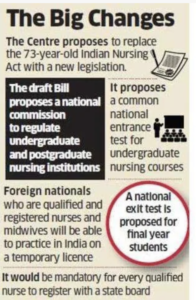Nursing is a noble profession. When epidemics like COVID-19 hit the country, they act as front line warriors. Hence welfare of nurses is utmost important. However recent protests and loopholes in the system present the very need of reforming the governance in the nursing sector.
Static dimensions
- Shortcomings of the nursing sector
- Regulatory mechanisms and loopholes
Current dimensions
- In news
- Solutions
- Nursing and Midwifery Commission Bill, 2020
Content:
In news:
- AIIMS nurses were on an indefinite strike recently and wrote a letter to the Director of AIIMS citing 23 unresolved demands.
- Their demand is not a pay hike, rather, that they be paid what is mentioned under the Sixth Pay Commission.
- The nurses are also protested against the reservation on the basis of gender at AIIMS that requires 80 per cent of the nursing staff to be female as the quota is leaving many qualified men unemployed.
- Their other demands were related to the pension scheme, cadre restructuring, qualification pay and modifications in job description.
- The nurses were angered by the hospital decision to outsource nurses on a contractual basis.
Shortcomings of the sector:
- The current nursing education is outdated and fails to cater to the practice needs.
- There are insufficient postgraduate courses to develop skills in specialities and address critical faculty shortages both in terms of quality and quantity.
- The number of nursing education institutions has been increasing steadily but there are vast inequities in their distribution, around 62% of them are situated in southern India.
- The faculty positions vacant in nursing college and schools are around 86% and 80%, respectively.
- The higher qualifications are underutilized, leading to low demand for postgraduate courses.
- Those with advanced degrees seek employment in educational institutions or migrate abroad which has led to an acute dearth of qualified nurses in the country.
- Small private institutions with less than 50 beds recruit candidates without formal nursing education.
- The nurses are out of the purview of the Consumer Protection Act which holds only the doctor and the hospital liable for medico-legal issues.
Regulatory mechanisms and loopholes:
- Nursing education in India has a wide array of certificate, diploma, and degree programmes for clinical and non-clinical nursing roles.
- The Indian Nursing Council regulates nursing education through prescription, inspection, examination, and certification.
- The induction requirements vary widely and so does the functioning of regulatory bodies in the States.
- 91% of the nursing education institutions are private and weakly regulated.
- The Indian Nursing Act primarily revolves around nursing education and does not provide any policy guidance about the roles and responsibilities of nurses in various cadres.
- The education, including re-training, is not linked to the roles and career progression in the nursing practice.
- Most nurses working in the public and private health sector are diploma holders and there is a lack of job differentiation between diploma, graduate, and postgraduate nurses regarding their pay, parity, and promotion.
Solutions:
- A common entrance exam, a national licence exit exam for entry into practice, and periodic renewal of licence linked with continuing nursing education would significantly streamline and strengthen nursing education.
- Amendments to the Indian Nursing Council Act of 1947 is required to explicitly state clear norms for service and patient care and fix the nurse to patient ratio.
- The jurisdictions of the Indian Nursing Council and the State nursing councils must be defined and coordinated to synergize their roles.
- Incentives to pursue advanced degrees to match qualification.
- Improvements in the status of nursing as a profession.
- Public-private partnership between private nursing schools/colleges and public health facilities would help enhance nursing education (NITI Aayog has recently formulated a framework for public-private partnership in medical education).
- Transparent accreditation, benchmarking, and ranking of nursing institutions too would improve the quality.
Nursing and Midwifery Commission Bill, 2020:
- The Ministry of Health and Family Welfare has finalised National Nursing and Midwifery Commission Bill 2020 to replace the Indian Nursing Council Act 1947.
- A common test would integrate the system similar to the National Eligibility-cum-Entrance Test for undergraduate medical courses.
- It also proposes a National Exit test for the final year of the nursing or midwifery course, to ensure uniform quality.
- The Indian Nursing Council will be replaced with a new representative body called National Nursing and Midwifery Commission.
- This body would have representatives of the Centre and the states, would frame policies and regulate standards for the governance of nursing and midwifery education.
- It would provide basic standards of education, physical and instructional facilities, training, research, maximum tuition fee payable in respect of various categories.

- The proposed commission would have different boards to regulate undergraduate and postgraduate education and assess and rate different institutions offering courses.
- Every nurse and midwife would have to register with the state boards and a national register would be maintained to track all qualified and practising nursing professionals.
- It proposes a temporary licence for foreign nationals who are qualified nurses and midwives to practice in India.
- What are the shortcomings of the nursing sector in India? How can they be resolved?
Approach to the answer:
- Write about the regulation of nursing and its loopholes
- Write the shortcomings of the nursing profession
- Write about the Nursing and Midwifery Commission Bill, 2020
- Write conclusion stating other solutions.
















